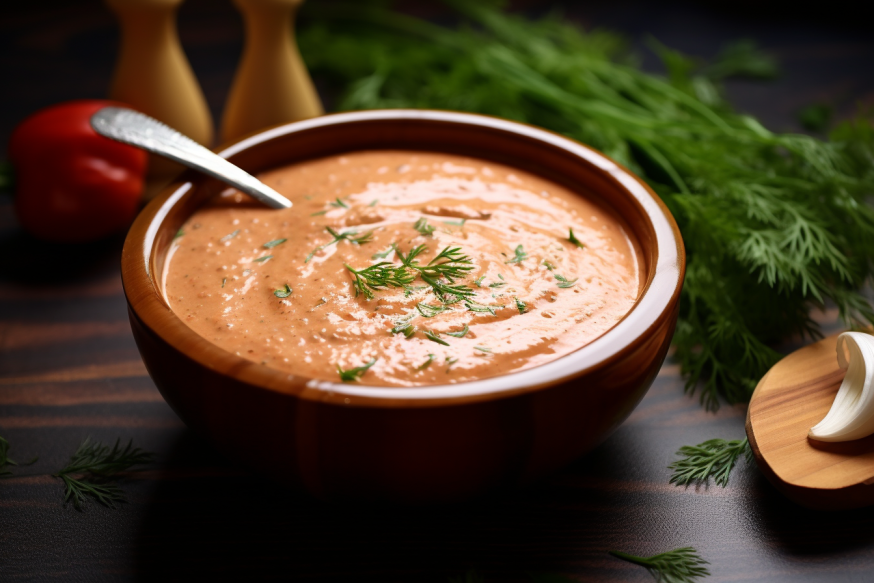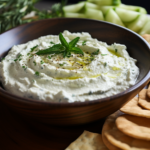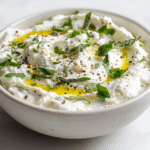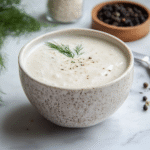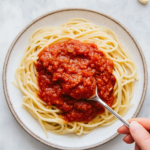I love Russian dressing! It’s this creamy, slightly spicy, pink spread made from mayo, ketchup, sour cream, horseradish, and dill relish. Surprisingly, it wasn’t born in Russia; folks say it was made in New Hampshire in the early 1900s. They called it ‘Russian dressing’ because the original recipe had caviar, a Russian thing.
So, my go-to dressing is mayo and ketchup-style chili sauce, sometimes mixed with Worcestershire sauce, horseradish, and paprika.
People mix up Russian dressing and Thousand Island because both start with mayo and ketchup, creating a pink dressing. But here’s the scoop: Thousand Island is a bit sweet with pickle relish, while Russian dressing has a spicy kick from horseradish and hot sauce. It’s my spicy pink favorite!
Best Russian Dressing Recipe
Equipment
- Medium bowl
- Measuring Spoons and Cups
- Stirring Utensil
- Tasting Spoon
- Airtight Container
Ingredients
- 3 tbsp ketchup-style chili sauce
- 1/2 cup mayonnaise
- 1 tbsp minced white onion
- 1/2 tsp Worcestershire sauce
- 1 tsp prepared horseradish
- 1/2 tsp smoked paprika
- 1/2 tsp kosher salt plus more as needed
- 1/4 tsp freshly ground black pepper
- 1/4 tsp dry mustard
Instructions
- In a medium bowl, combine the following ingredients:– 1/2 cup mayonnaise– 3 tablespoons ketchup-style chili sauce– 1 tablespoon minced white onion– 1 teaspoon prepared horseradish– 1/2 teaspoon Worcestershire sauce– 1/2 teaspoon smoked paprika– 1/2 teaspoon kosher salt– 1/4 teaspoon dry mustard– 1/4 teaspoon freshly ground black pepper
- Stir the ingredients thoroughly to ensure they are well combined.
- Taste the mixture and adjust the seasoning if necessary by adding more kosher salt or black pepper according to your preference.
Notes
What to Serve with Russian Dressing?
Russian dressing is a versatile condiment that adds a unique kick to various dishes. Here are some delightful options to serve with Russian dressing:
Russian Dressing vs Thousand Island Dressing
| Aspect | Russian Dressing | Thousand Island Dressing |
|---|---|---|
| Base Ingredients | Primarily mayo and ketchup, with a spicy kick. | Mainly mayo and ketchup, with a sweeter profile. |
| Distinctive Flavors | Notable for a hint of spiciness from horseradish. | Features sweetness from sweet pickle relish. |
| Additional Ingredients | May include chili sauce, Worcestershire, paprika. | May contain finely chopped hard-boiled egg, relish, chives, parsley, and sometimes hot sauce. |
| Historical Origin | May include chili sauce, Worcestershire, and paprika. | Emerged around the same time in the Thousand Islands region, between upstate New York and southern Ontario. |
| Signature Dish Pairing | Classic on Reuben sandwiches with corned beef. | Iconic on ’60s and ’70s salad bar-style salads. |
| Gray Area & Interchangeability | Ingredients may overlap; both can include Worcestershire, lemon juice, and paprika. | Names are sometimes used interchangeably; other sauces like special sauce and comeback sauce are variations. |
| Taste Profile | Offers a tangy, creamy brightness with a touch of heat. | Tends to be sweeter and milder, sometimes with a hint of hot sauce. |
| Common Additions | Onion powder, mustard powder, and diced pickles. | Chives, parsley, olives, bell pepper, and sometimes hot sauce. |
| Versatility | Ideal for Reuben sandwiches; adds a punch to various dishes. | Classic for salads; complements a variety of foods. |
| Storage | Can be refrigerated for up to a week. | Stays fresh when stored appropriately. |
| Popularity | Known for Reuben sandwiches; versatile and beloved. | A staple in classic salads; widely appreciated. |
| Interchangeable Names | Occasionally used interchangeably. | Names like special sauce and comeback sauce draw inspiration. |
| Modern Variations | May find versions in family gatherings or diners. | Familiar from family reunions, diners, or burger joints. |

